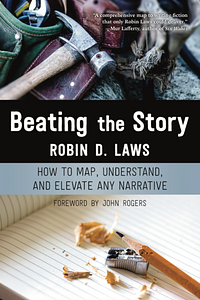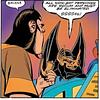Take a photo of a barcode or cover
A continuation of Laws' _Hamlet's Hit Points_, he takes the story beat premise he designed for that gaming title and tries to apply it to a broader story analysis and crafting tool. I'd say he's mostly successful. Bear in mind that I was mostly interested in this for it's ongoing gaming application, so some of the "here's how to use it as a professional writer" was directly on task for his thesis statement but wasn't super-relevant to me. I'd still recommend it for that purpose, and certainly for people who are interested in professional fiction as fiction.
A book on writing focused on the author's story beat mapping method first introduced as an aid to role-players in his book Hamlet's Hit Points.
This isn't just a rehash of the previous book with a different focus. It's a complete guide to writing fiction from conceiving the story to revising drafts. There's also a few notes on using the tools provided as an editor or collaborator, and even a small section on using them for critical analysis.
As with the first book, three full examples are broken down using the author's method. In this case a Mad Men episode, an X-Files episode, and a section of the novel The Color Purple.
While I'm not the core audience, I would recommend this book to any authors looking to add to their writing toolkit.
This isn't just a rehash of the previous book with a different focus. It's a complete guide to writing fiction from conceiving the story to revising drafts. There's also a few notes on using the tools provided as an editor or collaborator, and even a small section on using them for critical analysis.
As with the first book, three full examples are broken down using the author's method. In this case a Mad Men episode, an X-Files episode, and a section of the novel The Color Purple.
While I'm not the core audience, I would recommend this book to any authors looking to add to their writing toolkit.
First impressions of Beating The Story
I pre-ordered this book directly from the publisher, and so got a Kindle eBook version in advance of publication, as well as the paperback edition when it was published (which arrived about a week ago). That's why I am able to review this item before it's officially released on Amazon.
This book isn't about "structure" as it is commonly understood (e.g. "Three-Act Structure" or the "Freitag Pyramid", or "Hero's Journey", etc.) but about beat analysis: the micro-structure of a story. Beats are the Lego blocks of narrative. According to Laws, each "beat" of a story moves us between hope and fear, and an entertaining and engaging narrative will move us between these two opposite feelings in an unpredictable way. By analyzing these beats, we can gain insight into the way that writers before us have handled story problems, and we can analyze our own work and see where it can be improved.
Laws identifies quite a number of different beat types, and gives extensively-worked examples from classic literature. He also did this in his application of beat analysis to tabletop role-playing games, [i]Hamlet's Hit Points[\i].
This is a compact book, without fat or filler, but I think it will require a lot of study, thinking, and practice before I can apply it to my own attempts at writing. My first impression is that this will prove to be a really valuable book, however.
I pre-ordered this book directly from the publisher, and so got a Kindle eBook version in advance of publication, as well as the paperback edition when it was published (which arrived about a week ago). That's why I am able to review this item before it's officially released on Amazon.
This book isn't about "structure" as it is commonly understood (e.g. "Three-Act Structure" or the "Freitag Pyramid", or "Hero's Journey", etc.) but about beat analysis: the micro-structure of a story. Beats are the Lego blocks of narrative. According to Laws, each "beat" of a story moves us between hope and fear, and an entertaining and engaging narrative will move us between these two opposite feelings in an unpredictable way. By analyzing these beats, we can gain insight into the way that writers before us have handled story problems, and we can analyze our own work and see where it can be improved.
Laws identifies quite a number of different beat types, and gives extensively-worked examples from classic literature. He also did this in his application of beat analysis to tabletop role-playing games, [i]Hamlet's Hit Points[\i].
This is a compact book, without fat or filler, but I think it will require a lot of study, thinking, and practice before I can apply it to my own attempts at writing. My first impression is that this will prove to be a really valuable book, however.
So many writing books say the same thing, over and over, derived from screenplays. Beating the Story takes a different, broader perspective that focuses not so much on structure, but on essential story elements, and the details of pacing, particularly the audience's emotional investment. This really opened my eyes to some problems in the novel I've been struggling with for far too long. I expect to be coming back to this one again and again.
Beat mapping is a very structured, analytical way of looking at your story. Personally, I find a strong structure more inspirational than a blank page, so this book was a godsend. Especially when combined with the lessons I've learned from Mary Robinette Kowal.

